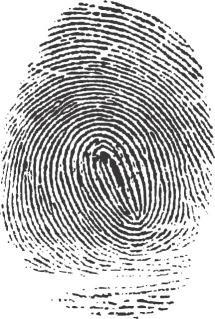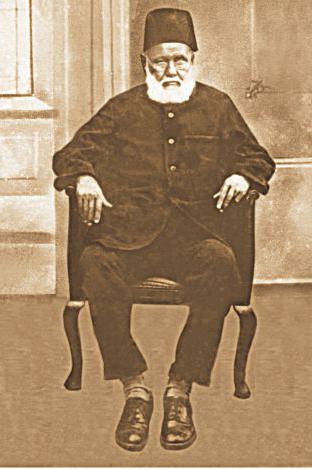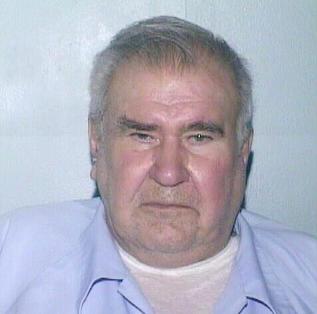
Forensic science, also known as criminalistics, is the application of science principles and methods to support legal decision-making in matters of criminal and civil law.

A fingerprint is an impression left by the friction ridges of a human finger. The recovery of partial fingerprints from a crime scene is an important method of forensic science. Moisture and grease on a finger result in fingerprints on surfaces such as glass or metal. Deliberate impressions of entire fingerprints can be obtained by ink or other substances transferred from the peaks of friction ridges on the skin to a smooth surface such as paper. Fingerprint records normally contain impressions from the pad on the last joint of fingers and thumbs, though fingerprint cards also typically record portions of lower joint areas of the fingers.

Diego Columbus was a navigator and explorer under the Kings of Castile and Aragón. He served as the 2nd Admiral of the Indies, 2nd Viceroy of the Indies and 4th Governor of the Indies as a vassal to the Kings of Castile and Aragón. He was the eldest son of Christopher Columbus and his wife Filipa Moniz Perestrelo.
Brain fingerprinting is a scientific technique which uses brain waves from a electroencephalography (EEG) to determine whether specific information is stored in the subjects cognitive memory. Brain Fingerprinting does not detect or measure lies, stress, and emotion. It is detected through brainwaves that measure the neurological behavior of the human brain. Brain fingerprinting is determined through information present or information absent. It has statistically proven to have no false positives and no false negatives The technique involves presenting words, phrases, or pictures containing salient details about a crime or investigated situation on a computer screen, in a series with other, irrelevant stimuli. Although Brain Fingerprinting has been scientifically proven to work and has been used in legitimate investigations, the test results themselves can not be admitted as evidence. However, information or material that was discovered during the test can be used as evidence in a legal trial.

Alphonse Bertillon was a French police officer and biometrics researcher who applied the anthropological technique of anthropometry to law enforcement creating an identification system based on physical measurements. Anthropometry was the first scientific system used by police to identify criminals. Before that time, criminals could only be identified by name or photograph. The method was eventually supplanted by fingerprinting.

Juan Vucetich Kovacevich was an Argentine anthropologist and police official who pioneered the use of dactyloscopy.
Articles related to criminology and law enforcement.
The Henry Classification System is a long-standing method by which fingerprints are sorted by physiological characteristics for one-to-many searching. Developed by Hem Chandra Bose, Qazi Azizul Haque and Sir Edward Henry in the late 19th century for criminal investigations in British India, it was the basis of modern-day AFIS classification methods up until the 1990s. In recent years, the Henry Classification System has generally been replaced by ridge flow classification approaches.

Sir Edward Richard Henry, 1st Baronet, was the Commissioner of Police of the Metropolis from 1903 to 1918. His time in the post saw the first discussions on the introduction of police dogs to the force, but he is best remembered today for his championship of the method of fingerprinting to identify criminals.
Alfred Edward Stratton (1882-1905) and his brother Albert Ernest Stratton (1884-1905) were the first men to be convicted in Britain for murder based on fingerprint evidence. They were both executed at 9 am on 23 May 1905 at HM Prison Wandsworth. The case, otherwise known as the Mask Murders, the Deptford Murders or the Farrow Murders, was one of the earliest convictions using forensic science.
Harry Jackson was the first person to be convicted in the United Kingdom via fingerprint evidence.
Shirley McKie is a former Scottish police detective who was accused by fingerprint analysis staff of the Scottish Criminal Record Office (SCRO) of leaving her thumb print on the bathroom door frame of a murder crime-scene in Kilmarnock on 14 January 1997. She denied she had ever been in the house of murder victim Marion Ross, but Detective Constable McKie was initially suspended, then sacked, then arrested by Strathclyde Police in 1998, and tried and acquitted in 1999. A scandal subsequently developed because of allegations of misconduct on the part of the SCRO and the police.
Criminal Justice Information Services is a department of the Scottish Police Services Authority. Previously called the Scottish Criminal Record Office (SCRO), it established in 1960 with a mission statement "To manage information for the Scottish Police Service, wider Criminal Justice Community and the public to assist in the prevention and detection of crime and enhance public safety." The organisation is based at Pacific Quay in Glasgow, under current Director John McLean.

Necochea is a port and beach city in the southwest of Buenos Aires Province, Argentina. The city is located on the Atlantic coast, along the mouth of the Quequén Grande River, 528 km (328 mi) from Buenos Aires and 120 km (75 mi) southwest of Mar del Plata. The city proper has 90,000 inhabitants per the 2010 census [INDEC] and is the seat of government for Necochea Partido.

Khan Bahadur Qazi Azizul Haque was a Bengali inventor and police officer in British India, notable for his work with Edward Henry and Hem Chandra Bose in developing the Henry Classification System of fingerprints, which is still in use. Haque provided the mathematical basis for the system.

William George Heirens was an American criminal and possible serial killer who confessed to three murders. He was subsequently convicted of the crimes in 1946. Heirens was called the Lipstick Killer after a notorious message scrawled in lipstick at a crime scene. At the time of his death, Heirens was reputedly Illinois' longest-serving prisoner, having spent 65 years in prison.

The murder of June Anne Devaney is a British child murder which occurred on 15 May 1948 when a girl aged 3 years 11 months was abducted from her cot while an inpatient at Queen's Park Hospital in Blackburn, Lancashire. The child was removed to the grounds of the hospital, where she was raped, before suffering extensive blunt force trauma to her skull when her head was repeatedly swung into a sandstone wall. This assault caused extensive internal injuries and multiple skull fractures, causing the child to develop a fatal state of shock. Her murderer, 22-year-old Peter Griffiths, was arrested three months after the crime and was subsequently tried and convicted of June Anne's murder. He was hanged on 19 November 1948.

The Heavy Hand of the Law is a 2017 Argentine legal drama film directed by Fernán Mirás from a screenplay he co-wrote with Roberto Gispert. Produced by Fernando Sokolowicz, the film stars Paola Barrientos as Gloria Soriano, a public defender disillusioned with her work for never having defended an innocent when she gets involved in a legal case regarding a rape in El Escondido, a fictitious town located in the deep interior of Buenos Aires with a pleading wrote by her former teacher and aspiring to a seat in the Argentine Judiciary, Prosecutor Mercedes Rivas.

Sres. Papis is a Chilean telenovela based on the Argentine telenovela of the same name. It premiered on Mega on June 28, 2016 and ended on March 6, 2017. It stars Francisco Melo, Jorge Zabaleta and Simón Pesutic.
David Smith is an English repeat murderer, rapist and suspected serial killer who came to national prominence in 1999 when he was convicted of murdering a sex worker six years after having been acquitted of an "almost identical" murder. Cleared of the murder of 33-year-old west London sex worker Sarah Crump in 1993, Smith was found guilty in 1999 of the killing of 21-year-old Paddington sex worker Amanda Walker. Smith has since been linked to a number of other murders of sex workers across Britain.












